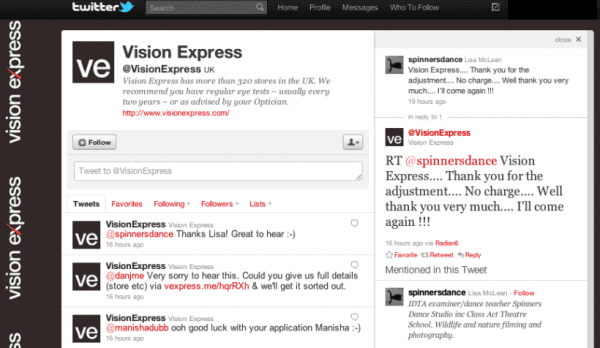In this case study, we talk to Kate Webb, the Online Marketing Manager at Vision Express. Kate talks about how they have developed a strategy and manage social media marketing across the Vision Express teams. Thanks for sharing your experiences, Kate!
How big an impact has the increase in popularity of social media with consumers had on Vision Express?
It’s had quite an impact in terms of time and resource, especially in the early days.
As a company we’re relatively new to social media, we’ve only been active for just over eighteen months. We spent a lot of time during the first 3-6 months listening, watching and learning what consumers were saying about our brand/looking for from our brand, in order to decide on how we should communicate, and where – which platforms.
During this time we have seen both our follower/fan numbers grow, but more importantly the engagement with our customers is increasing and we feel that our customers are really starting to converse with us as a brand.

Since being involved in social media, we have seen an increase in the number of customers who mention us directly, or seek us out, rather than simply mentioning our brand name in passing conversation. To us this is an important development in building our customer relationship.
At Vision Express our social media activities are based on engaging with our existing customer base, we want to improve on relationships, or continue offline relationships, with our customers, online. In the optical industry we have a long purchase cycle, on average our customers come back to us every 2 years, so it is a long period during which to maintain our social media relationships.
"We have found that for probably about 1-2%, of our customer base, social media is their main point of contact with us. The type of communication varies between the different social media platforms, for example we find that Twitter is more of a customer service tool, whilst Facebook is a fun and engaging platform, suitable for promotional outreach".
There is still progress to be made, especially since social media grows and platforms are developed/changed, but we’re confident we’re on the right track to providing the same high level of service, that our customers get in our stores, online.
What do you see as the key parts of a social media strategy that require management?
I find that too often businesses think that social media is just about posting messages about the company on Twitter or Facebook, or getting an agency in to handle everything for them. But the key to making social media work, for me, is to have a strong strategy behind it, and to manage that strategy.
For me the key areas of focus in this strategy should be:
- Brand/Business persona: I feel it’s key to define a persona or personality for your business and to identify how you want to position your brand on social media, is the brand/business fun/funky, calm/serious, sensitive/nurturing or brash/loud? You need flexibility to evolve this over time as your relationship with customers grows.
- Goals/Objectives: It is important to ensure that your social media objectives or goals are aligned with that of your organisation. What is it that you want to achieve via social media. For Vision Express, our 3 critical goals are to:
• Add value and service to our online customers, via informative dialogue, responsive customer service and feedback. This also works as a 2-way path, in that we then pass onto our store network all/any feedback we have received from our online customers.
• Engage with our online customers, and build relationships with them. In order to do this effectively, we are working towards a one customer view database, which will enable us to match social media activity to in-store activity by our customers, thus enabling us to provide a tailored approach in our conversations.
• Build brand awareness and consumer knowledge about our service offering. We want our customers to understand our company, and to recognise our values, ethics and personality, online & offline.
- Which Platforms?: There are hundreds of social media platforms that we could all be involved in, so it’s key to identify which platforms support your business objectives, and which ones you are going to get involved with. Otherwise resources and communication will simply be spread too thinly.
- Analytics/Results: Be this sentiment or engagement levels, reporting on results/analytics needs to be regular, managed and analysed in order to adapt future strategy.
Technology Advancements: Social media platforms are changing all the time, because of this it is imperative that we understand and gain knowledge of how these advancements/changes will affect our business’s social media presence going forward. For example the development of Facebook’s iframes in March this year, opened up a great opportunity for us to integrate our websites core offers into our Facebook page.
Prioritising different opportunities from social
How should a company assess the relevance of different social media opportunities to prioritise their focus?
Having clear objectives and a clear strategy will help. Enabling you, on a case by case basis, to identify what social media opportunities work for which promotion/aspect of the business.
It’s important for any business/brand not to spread their actions/activities too thinly, identify where the majority of your customers are and focus on engaging well with your customers on a few platforms.
As well as identifying which platforms to be active on, it’s important to also understand to what extent you work with these platforms, does your business need/require interactive apps or games? Or is simple communication the key to your social media engagement.
I feel it is also important to identify where social media fits in with your overall online and offline presence, and ensure that it complements your other activities. Recently I have seen an increase in brands advertising both online and on TV their Facebook and Twitter presences, but not their website? To me, a brands website should take precedence, and social media presences should complement the website messaging and be aimed at engaging customers with the website.
If through doing these engagement activities we acquire customers, then great, but this isn’t our primary focus.
What advice would you give to a company starting a social media listening / reputation management initiative?
Listen, listen and listen some more. Social media isn’t about who shouts the loudest, it’s about engaging in conversation with your customers/prospective customers and about keeping them informed.
There are some free tools which you can use at the very beginning, such as Tweetdeck or Hootsuite, but bear in mind these are often limited to either 1 platform, or to scheduling outreach messages only.
If you are really serious about social media, and I think companies need to be these days, you need to enlist a social media monitoring platform, which will enable you to listen to what consumers are saying about your brand across micromedia (Twitter/Facebook), blogs and forums.
You won’t be able to respond to all consumer mentions, due to forum rules, but you can at least listen and feed this back into the business, so you can modify activities, or continue doing popular ones!
Start small, don’t overstretch your resources, and be realistic about the amount of time/resource and money social media can take up.

A few key things to remember are once you start talking, you need to continue the commitment to maintain the conversations, and ensure you gain inter-company awareness, there is nothing worse than talking to a customer via Twitter, and then having them go into store to be presented with “We’re on Twitter? I didn’t know that”.
You will also need to get to know your customers, the ideal solution here is to integrate social media activities into your core customer database, so you have one customer view, but this can take time, money and resource. In the interim, the better social media monitoring tools these days are offering engagement platforms, which allow you to add notes and assign tasks, so you can build up a reasonable knowledge of your social media customers.
Where do you think the responsibilities for managing social media marketing in a company should lie? How is it managed at Vision Express?
By spending our first 3 to 6 months listening to what our customers were saying about our brand/looking for from our brand, we managed to identify that our social media activities needed to be part of the whole business, not just an ‘add-on’ to our marketing activities.
It is important that social media activities have management ‘buy-in’ in any business. It needs to be integrated into core business activities if it is going to work properly.
To integrate these activities into different departments correctly requires management support, the management structure need to understand why/how/who social media impacts on and affects both internally and within our customer base.
As a result, so far, we’ve integrated social media into a couple of key departments within the business, with the Online Marketing team as social media ‘owners’, in that we will identify the next strategic steps, bring in agency support, provide understanding of new developments and report on analytics and progress.
We have involvement from our Customer Care team, who respond on a day-to-day basis to customer enquiries/queries and feedback. We integrate social media into our marketing planning activities from the out-set, identifying whether a promotion is suitable for social media and if so, which platform it suits best, and we have our Product Department involved to provide a great level of product information and advice
To have social media as purely a marketing tool/activity, will restrict a business in providing the right level of customer care, and will lead to sporadic/untimely and unfocused outreach.








